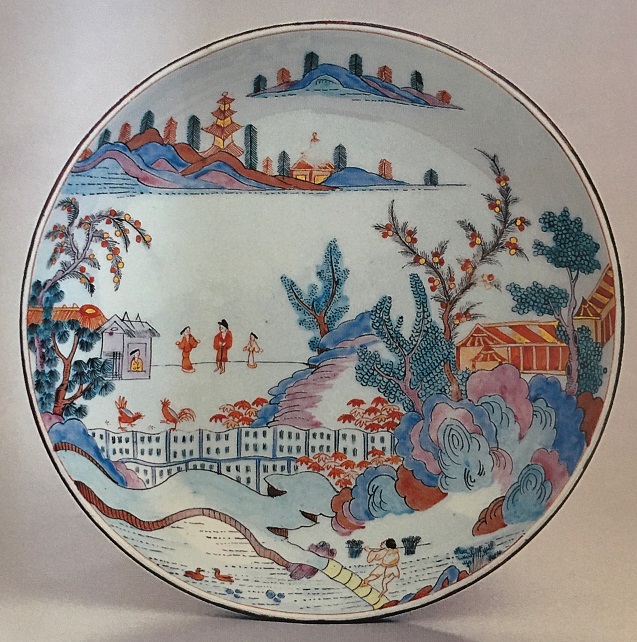Sold Ceramics

Sold Ceramics - Sold Japanese Tea, Coffee and Chocolate wares 18th Century - Page 2
Object 2012231
Saucer
Japan
1700-1720
Height 25 mm (0.98 inch), diameter of rim 122 mm (4.80 inch), diameter of footring 59 mm (2.32 inch), weight 92 grams (3.25 ounce (oz.))
Saucer on footring, straight rim with a slightly everted edge. Imari decorated in underglaze blue, iron-red, black, gold and various other overglaze enamels, with in the foreground a spit of land with a man on a bridge, rocks at right, trees and a pavilion. To the left of this chickens behind a fence, three standing figures and another figure in a small house. In the background hills with a pagoda and a pavilion. On the rim a zig-zag lines-pattern border and on the reverse three groups of flower sprays.
The design on this Japanese saucer was taken as an example to be used on a Dutch over-decorated dish in the Jan Menze van Diepen collection (JMVD-P-1037). On this dish the Dutch artist did his best to recreate a Chinese scene, incorporating many elements of Oriental porcelain. These include the motif of the man with a carry-pole on his shoulder, the composition of the landscape, the out-of-perspective pavilion at right and the way the spit of land is depicted. Moreover, some elements of the original were not well understood, such as the rocks at the right, which look more like clouds. The painter combined all these elements in a Western way, thereby creating a Chinoiserie. (Jörg 2002/2, p.156, cat. 109)
(Dish reproduced from: Jan Menze van Diepen Stichting. Selectie uit de collectie Oosterse keramiek. (Jan Menze van Diepen Foundation. A Selection from the Collection of Oriental Ceramics), (C.J.A. Jörg, Slochteren, 2002), p.156, cat. 109 this dish is not included in this sale/offer)
The decorative style on this saucer is very similar to that used on other, earlier sold, Japanese Imari tea ware. The translucent enamel colours, the zig-zag lines-pattern borders and the reverses with the three widespread flower sprays are all very similar. This could indicate that these may be the product of a single workshop but may or may not be the product of a single kiln, specialised in these high-quality tea wares. Judging by Dutch 18th century sales and inventories, Japanese porcelain was quite expensive at the time and even more highly valued than its Chinese counterpart.
For, earlier sold, Japanese tea wares decorated in this similar style, please see:
- Sold Ceramics - Sold Japanese Tea, Coffee and Chocolate wares 18th Century - Page 1 - Objects 2010334 and 2011366.
-
Sold Ceramics - Sold Japanese wares with Western Designs 1653-1800 - Object 2012088.
-
Sold Ceramics - Sold Japanese wares with Western Designs 1653-1800 - Object 2010609.
Condition: A filled hole in the centre.
References:
Jan Menze van Diepen Collection of Oriental Ceramcis object: JMVD-P-1037
Price: Sold.



 create websites
create websites